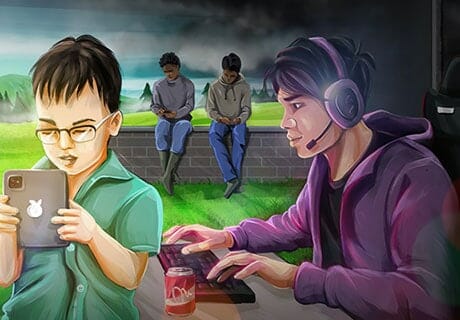For decades, video games have been a popular form of entertainment for children and adults alike. From the early days of arcade games to the now ubiquitous online multiplayer games, the gaming world has expanded exponentially, offering a variety of experiences. However, as a parent, you might be concerned about the potential impact of video games on your child’s health, learning, and social development. This article aims to provide insights into the world of video games, offering tips on how to ensure a healthy gaming environment for your children.
Understanding the Gaming World
Understanding the nature and content of the video games that your child engages with is essential in fostering healthy and beneficial gaming experiences.
Here’s an expanded explanation of the subject:
Types of Games
-
Educational Games
 Benefits: These games are designed to teach specific subjects like math, science, or language. Depending on the content, they may help improve memory and cognitive abilities and promote learning through interactive experiences.
Benefits: These games are designed to teach specific subjects like math, science, or language. Depending on the content, they may help improve memory and cognitive abilities and promote learning through interactive experiences.
Challenges: If not selected carefully, the educational value might be limited, and they might not align with the child’s academic curriculum.
-
Puzzles
Benefits: Puzzles stimulate critical thinking and logic skills. They help enhance spatial recognition and may boost a child’s self-esteem as they solve complex problems.
Challenges: Some puzzles may be too challenging for younger children, leading to frustration.
-
Adventure Games
 Benefits: These games usually involve exploration, problem-solving, and narrative engagement. They foster creativity and can improve reading comprehension and empathy as players engage with storylines.
Benefits: These games usually involve exploration, problem-solving, and narrative engagement. They foster creativity and can improve reading comprehension and empathy as players engage with storylines.
Challenges: The content in some adventure games may be inappropriate for younger children, so monitoring and selection are key.
-
Strategy and Role-playing Games (RPGs)
Benefits: Strategy games enhance problem-solving and critical thinking, while RPGs allow players to take on different roles, helping in the development of empathy and social skills. Both can improve hand-eye coordination and decision-making skills.
Challenges: Some strategy and RPG games may involve complex themes or violent content, which might not be suitable for younger players.
-
Shooter Games
 Whether children should play shooter games is a personal decision that should be made by parents or guardians, taking into consideration the child’s age, maturity level, and the specific content of the game. It may be beneficial to consult rating systems, read reviews, and even play the game yourself to determine whether it aligns with your comfort level and your child’s developmental stage.
Whether children should play shooter games is a personal decision that should be made by parents or guardians, taking into consideration the child’s age, maturity level, and the specific content of the game. It may be beneficial to consult rating systems, read reviews, and even play the game yourself to determine whether it aligns with your comfort level and your child’s developmental stage.
If you decide to allow your child to play these games, setting clear boundaries, monitoring gameplay, and engaging in open communication about the game’s content can foster a more responsible and positive gaming experience.
Establishing Healthy Gaming Habits
Understanding what your child is playing helps in recognizing the underlying educational and developmental values of video games, but it’s only the first step. Active engagement, monitoring, and encouraging a balanced lifestyle are vital in establishing healthy gaming habits. By doing so, parents can ensure that their children are not only having fun but also learning and growing through their gaming experiences.
- Understanding Content and Ratings:
Parents should take the time to understand the content, themes, and ratings of games to ensure they are age-appropriate.
- Setting Time Limits:
Balancing gaming with other activities is crucial. Parents should establish a clear routine that includes time for homework, outdoor activities, and social interaction… See ‘Setting Limits’ below.
- Engaging with Children:
Parents can play with their children to understand the nature of the games and to foster communication about what they are learning and experiencing.
- Encouraging Positive Games:
Parents should encourage games that align with their children’s interests and developmental needs, fostering skills that will be beneficial in their academic and personal growth.
- Monitoring Online Interactions:
If the child is playing online, parents should be aware of who they are interacting with and establish rules around online communication to ensure a safe environment.
- Children should not game where they sleep
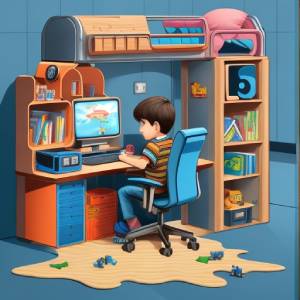 This emphasizes the importance of separating gaming activities from the sleep environment. Allowing children to game in their bedrooms, especially close to bedtime, can blur the lines between spaces for rest and entertainment. This mixture can lead to difficulties in falling asleep, as the excitement and stimulation from video games can hinder the body’s ability to wind down and transition into sleep mode. Moreover, the blue light emitted by screens can suppress melatonin production, a hormone essential for sleep regulation. Creating designated areas for gaming outside the bedroom encourages a mental separation between play and rest, reinforcing healthy sleep hygiene. It can also allow parents to monitor gaming content and time more easily, ensuring that gaming habits align with the family’s values and guidelines. Therefore, preserving the bedroom as a tranquil space dedicated to rest can promote overall well-being and a more balanced lifestyle for children.
This emphasizes the importance of separating gaming activities from the sleep environment. Allowing children to game in their bedrooms, especially close to bedtime, can blur the lines between spaces for rest and entertainment. This mixture can lead to difficulties in falling asleep, as the excitement and stimulation from video games can hinder the body’s ability to wind down and transition into sleep mode. Moreover, the blue light emitted by screens can suppress melatonin production, a hormone essential for sleep regulation. Creating designated areas for gaming outside the bedroom encourages a mental separation between play and rest, reinforcing healthy sleep hygiene. It can also allow parents to monitor gaming content and time more easily, ensuring that gaming habits align with the family’s values and guidelines. Therefore, preserving the bedroom as a tranquil space dedicated to rest can promote overall well-being and a more balanced lifestyle for children.
Setting Limits
Although video games can provide several cognitive benefits, excessive screen time can lead to a sedentary lifestyle and other health issues. According to the American Academy of Pediatrics, parents should limit screen time, including video games.
Here are some guidelines [1,3] for parents to limit their child’s gaming include:
- Gaming should only happen after the child completes other responsibilities like homework and chores, treating gaming as an earned privilege, not an entitlement.
- Set clear time limits on gaming, with recommendations from the American Academy of Pediatrics suggesting under 30 to 60 minutes on school days and 2 hours or less on non-school days. For younger children, even lower limits are recommended, and some days each week should involve no gaming to encourage other non-screen activities.
- Establish a reasonable time frame for reassessing the rules, allowing for adjustments based on the child’s adherence and progress.
- Determine a realistic consequence for breaking the rules, which should be enforceable and immediately applicable rather than imposing long-term restrictions.
- Parents should be aware of the games their child is playing and have the right to set rules about the types of games allowed, particularly avoiding those with extreme violence or graphic content.
- Consistently monitor and apply the rules, not bending them based on circumstances or emotions, and both parents should be involved and on board with the rules.
- Encourage other recreational activities to replace excessive gaming, offering alternative activities that the child can enjoy with family members during the typical gaming times.
- Provide positive reinforcement for non-gaming activities to improve the child’s relationship with the parents and reward engagement in healthy recreational activities.
Read about our “Points and Reward System” for Screen Time Management to foster a healthier balance in their child’s life.
Choosing Age-Appropriate Games
Not all games are suitable for all ages. Be vigilant about your child’s games by checking their Entertainment Software Rating Board (ESRB) ratings, which provide age recommendations and content descriptions. Some games may contain violent or explicit content that is not appropriate for younger players.
Online Safety
Many games now offer multiplayer options, meaning your child could be playing with others worldwide. Talk to your child about online safety, including the risks of sharing personal information, and encourage them to report inappropriate behavior. Most gaming platforms have parental controls and privacy settings that you can utilize to create a safer online environment.
Positive Engagement
Instead of a purely restrictive approach, try engaging with your child’s gaming interests. Play games together as a shared activity, which can be a fun way to bond and understand your child’s gaming experience. Moreover, it allows you to monitor and discuss the content with your child.
Final Thoughts
Navigating the gaming world as a parent can be a challenging task, but with understanding, engagement, and setting clear boundaries, video games can be a positive part of your child’s life. Remember, communication is key. Discussing their games allows you to share their interests while conveying essential lessons on balance, safety, and healthy habits.
Case-Study: Roblox and Child Safety
Roblox (www.roblox.com) is an online platform that allows users to create and play games created by other users. While it’s popular among children and has many games designed for younger audiences, there have been concerns and reports about inappropriate content and interactions on the platform.
Some of these issues include:
-
Inappropriate Content:
Some user-created games or avatars might include content that’s not suitable for children. Roblox has measures to restrict these types of content, but some might still slip through.
-
Inappropriate Interactions with Adults:
As an online platform with multiplayer capabilities, children can interact with other users, including adults. There have been reports of inappropriate or predatory behavior by some adults toward minors.
-
Chat and Communication:
While allowing friends to communicate, the chat function can also be used by strangers to send inappropriate messages to children. Though there are filters to block certain content, they may not be foolproof.
-
Microtransactions:
Children might be exposed to in-game purchases, which can lead to unexpected expenses if not monitored properly.
-
Cyberbullying:
Like many online platforms, there can be instances of cyberbullying among users.
Roblox provides various parental controls, privacy settings, and content restrictions to help parents create a safer environment for their children (See: “Roblox Community Standards“). Parents can set up age-appropriate restrictions, control who can communicate with their child, monitor game history, and more.
However, these measures might not be sufficient to completely mitigate all risks. It still requires active parental involvement, guidance, and open communication to ensure that the child’s experience on Roblox or similar games is both fun and safe. Parents should understand the platform’s capabilities and risks, set clear rules and boundaries, and regularly discuss online safety with their children.









 Snacks
Snacks Water
Water Eye Sight
Eye Sight Hearing
Hearing




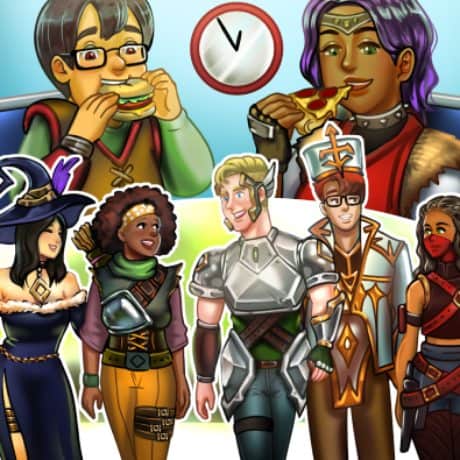









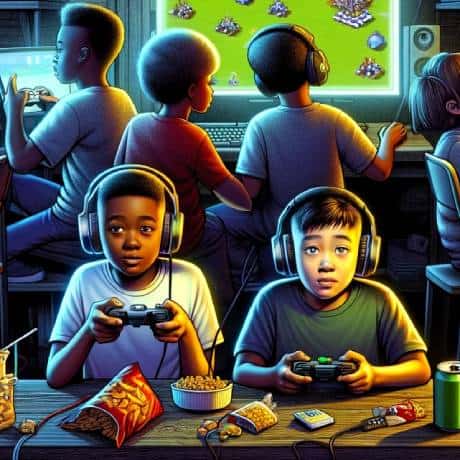



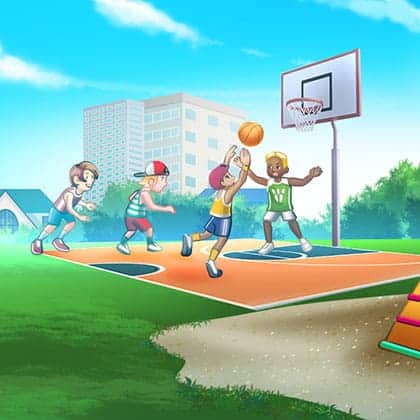



 Benefits: These games are designed to teach specific subjects like math, science, or language. Depending on the content, they may help improve memory and cognitive abilities and promote learning through interactive experiences.
Benefits: These games are designed to teach specific subjects like math, science, or language. Depending on the content, they may help improve memory and cognitive abilities and promote learning through interactive experiences. Benefits: These games usually involve exploration, problem-solving, and narrative engagement. They foster creativity and can improve reading comprehension and empathy as players engage with storylines.
Benefits: These games usually involve exploration, problem-solving, and narrative engagement. They foster creativity and can improve reading comprehension and empathy as players engage with storylines. Whether children should play shooter games is a personal decision that should be made by parents or guardians, taking into consideration the child’s age, maturity level, and the specific content of the game. It may be beneficial to consult rating systems, read reviews, and even play the game yourself to determine whether it aligns with your comfort level and your child’s developmental stage.
Whether children should play shooter games is a personal decision that should be made by parents or guardians, taking into consideration the child’s age, maturity level, and the specific content of the game. It may be beneficial to consult rating systems, read reviews, and even play the game yourself to determine whether it aligns with your comfort level and your child’s developmental stage. This emphasizes the importance of separating gaming activities from the sleep environment. Allowing children to game in their bedrooms, especially close to bedtime, can blur the lines between spaces for rest and entertainment. This mixture can lead to difficulties in falling asleep, as the excitement and stimulation from video games can hinder the body’s ability to wind down and transition into sleep mode. Moreover, the blue light emitted by screens can suppress melatonin production, a hormone essential for sleep regulation. Creating designated areas for gaming outside the bedroom encourages a mental separation between play and rest, reinforcing healthy sleep hygiene. It can also allow parents to monitor gaming content and time more easily, ensuring that gaming habits align with the family’s values and guidelines. Therefore, preserving the bedroom as a tranquil space dedicated to rest can promote overall well-being and a more balanced lifestyle for children.
This emphasizes the importance of separating gaming activities from the sleep environment. Allowing children to game in their bedrooms, especially close to bedtime, can blur the lines between spaces for rest and entertainment. This mixture can lead to difficulties in falling asleep, as the excitement and stimulation from video games can hinder the body’s ability to wind down and transition into sleep mode. Moreover, the blue light emitted by screens can suppress melatonin production, a hormone essential for sleep regulation. Creating designated areas for gaming outside the bedroom encourages a mental separation between play and rest, reinforcing healthy sleep hygiene. It can also allow parents to monitor gaming content and time more easily, ensuring that gaming habits align with the family’s values and guidelines. Therefore, preserving the bedroom as a tranquil space dedicated to rest can promote overall well-being and a more balanced lifestyle for children.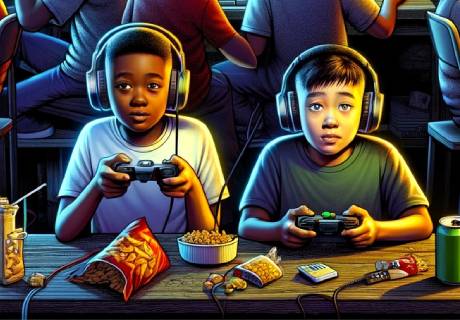
 Screen Time
Screen Time Play Sports
Play Sports
